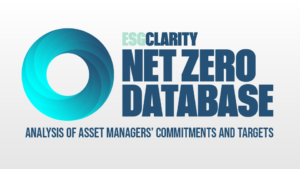In this Green Dream episode, Sawan Wadhwa, head of stewardship at Evenlode Investment, gives his thoughts on the suspension of the Net Zero Asset Manager initiative (NZAMi) as it conducts a review of its activities, with the firm continuing to use NZAMi’s net-zero assessment as part of its engagement strategy.
He also discusses how Evenlode is prioritising transition planning and remuneration this proxy voting season, and talks about the backlash against diversity, equity and inclusion (DEI) in the US.
Watch the full video interview above and read the transcript below.
MN: Hello and welcome back to the Green Dream video series. I’m Michael Nelson, senior global reporter at PA Future. And today I have the pleasure of chatting with Sawan Wadhwa, he’s the head of stewardship at Evenlode Investment. Sawan, fantastic to have you on the series.
SW: Thanks for having me, Michael.
MN: Given your line of work, obviously we’ll be talking about engagement today, but I first wanted to take the opportunity to ask you about the Net Zero Asset Management Initiative. Evenlode has been a member of NZAM since June 2021. NZAM suspended operations last month while it conducts a review to ensure it remains, in its words, fit for purpose. What are your thoughts on that given the wider global context?
SW: Yeah. So, I think my understanding is that the suspension was related to the initiative’s role in target setting and accountability. And I think the targets and the commitments made by individual signatories are still valid, right. That hasn’t really changed. I think it’s important to know that the initiative was launched in December 2020. And now we’re in 2025. What it does is ask signatories to review their own targets every five years. So, the fact that they are themselves reviewing it now seems sensible, right? I think that’s a positive.
Now, in terms of our own responsibilities, I think it’s important to highlight that, before we signed up to the NZAM initiative, we were doing this beforehand. We look at environmental and social and governance considerations as a way to manage long-term risks for our clients. We actually only really used the initiative for comparability purposes. We wanted to use the framework as a bit of a benchmark to assess how we were doing against the asset managers that we look up to, but then also to use the framework to assess the companies that we invest in because it is actually quite useful.
I think it’s probably good timing for the initiative to review their own fit-for-purpose sensibility. But, let’s wait and see. There is a consultation coming up in a few weeks time, I believe, which we will be involved in, so we will be part of the ongoing discussion there as well.
MN: Do you still analyse the emission intensity of your portfolio? If so, how is that going and what progress have you seen since the last report?
SW: Yeah. We started the emissions analysis of all of the funds, I think it was 2018, that was the first report that we started. And, to be honest, we continue to do that. It actually forms part of our net zero assessment. I think criteria number three and criteria number four within the NZAM framework are looking at emission intensity and emissions disclosure. It’s actually quite useful for us, as we were doing that beforehand, and we’re continuing to do it now.
In terms of what we’ve seen so far, unfortunately, we haven’t been able to do the analysis this year because the data hasn’t become available yet. The data will become available in March this year because we rely on external data sets for the analysis. And, although the companies have started to report their own emissions, a lot more than they used to back in 2019, 2018, we still rely on the third-party data sets because not 100% of the portfolio does disclose Scope One, Two and Three emissions.
In terms of the progress that we’ve seen, there was a big reduction in our emission intensity of all the funds last year. For 2023 data, it was roughly a 30% reduction from the year before. Now that is a big number, and there are some caveats to that. We did do an attribution analysis last year, which we’re going to continue doing in the following years, to basically figure out where the reductions were coming from. And the analysis identified three areas. At a company level, for example, we noticed that as companies start reporting their emissions, they tend to be more accurate. And they tend to be very different to the extent of the data sets, so you see a natural reduction in company emissions as they report more, and that’s where we saw there was a big reduction.
Then secondly, just general operational, value chain emission reductions that companies are obviously trying to take this a lot more seriously and trying to reduce their cost of capital in doing so, trying to reduce their emissions. We did see a big reduction in operational and value chain emissions. This is Scope Two and Scope Three.
And then, finally, portfolio construction. We’re not a sustainability fund, we manage a couple of income funds. We have a growth fund. We wouldn’t just divest companies because they’re super emission intensive. But we have noticed that there has been a reduction in emissions as we have divested from some of the more emission-intensive holdings for other fundamental investment reasons. I think, in terms of the attribution, we noticed that there was roughly 8% of the reductions that we saw from the 30% reductions, that came from companies becoming more efficient. That is positive. But yeah, there’s a long way to go because there are lots of caveats to the analysis that we need to talk about.
MN: And I suppose, as part of that, how do you engage with these investee companies on their net zero targets and emissions reduction?
SW: Yeah. So, again, the emissions analysis and the net zero assessments that we do are a big part of our engagement strategy. The emissions analysis allows us to focus on the most emission-intensive holdings, so give us the top ten of each fund. Again, that gives us a nice focus list of the companies that we should be engaging with. And then secondly, the net zero assessment allows us to look at the laggards. The companies that are not really performing very well, and not really disclosing the net zero transition plan, that also gives us a list. We tend to accumulate those two lists together and focus on the companies that are emission-intensive and the companies that are lagging behind in the net zero transition plan. And that gives a really nice foundation to engage with the companies and try to get to our 2025 target, which is 50% of our invested AUM to be either aligning or aligned to the Net Zero Asset Managers initiative.
MN: And so, while we’re on the topic of engagement, proxy seasons on the horizon, what are your priorities this year?
SW: Proxy season has basically begun, we’ve already voted on around nine or 10 meetings. I think the biggest one for us is looking at the climate transition plans. We haven’t had a lot of climate transition plans over the last five years, but we have noticed there’s been a bit of an uptick on that. We’re going to be focusing a lot more on that because, as we know, these climate strategies, for certain companies, they’re so intertwined with the long-term business strategy of the business that we really need to figure out that whatever the climate transition plan is, does it actually make sense, because shareholders need to vote on it, and it’s so intertwined with the longer term strategy of the business nowadays.
Secondly, again, the flagship fund is a UK-based fund. Remuneration is always a big topic. This year we’re focusing a little bit more on the actual targets themselves and making sure that they are becoming challenging year on year. We don’t really want companies to be remunerating their executives for setting really, really weak targets, we need to focus on the overall performance and pay alignment. And also, just generally speaking, we want good executives to be paid for their performance, and we’ve seen a lot of UK executives move to the US because they feel like they’re not getting paid enough. So, when we do see a remuneration policy that we like, we do advocate for the UK executives to be paid for what they’re worth. We are engaging with those companies to talk about that aspect of the remuneration policy as well.
MN: So, I suppose more on the social side of things, several large US companies are pulling back on previously stated ambitions to expand their diversity, equity and inclusion in the workplace. And filers of anti ESG proposals are also beginning to focus on curtailing DEI practices. Is this something that concerns you, and what can you do as an investment manager to safeguard and enhance DEI practices at your investee companies?
SW: Yeah, yeah, it’s a pretty big question, isn’t it? I mean, in short, yes. It is concerning because the ESG industry has made quite significant progress in recent years in trying to demonstrate how increased diversity can have a positive impact on companies and can lead to better decision-making. Now, I’m not going to go into a lot of detail in terms of why that is. I think we all understand where that is coming from. But, obviously, there are some caveats. Hiring a diverse workforce doesn’t always increase our performance, it really has to be embedded within the culture of the business.
Now, I do think that there are some criticisms of some DEI policies that we’ve seen, and they are valid because they tend to be sometimes quite performative in nature. And, you know, it’s quite interesting that a lot of those companies that were talking about these practices have now retracted. So, it is quite interesting. And that actually presents us with a bit of an engagement opportunity to really talk to them and try to engage with them in a much more productive way.
I think it’s really important to highlight, and I think this might be a bit of an obvious statement, but, you know, ESG covers a broad range of things, a broad range of responsible investment practices, whether it’s decarbonisation, whether it’s social issues and the supply chain, and whether it’s DEI practices. If you try to put them all into this big ESG bucket, it does create a bit of confusion for the stakeholders and for the retail investors. This politicisation of DEI and the industry, obviously, unfortunately, has had a bit of a negative impact on the overall industry. It’s important to think of these things in different kinds of buckets instead of putting them into one ESG umbrella. But hopefully over time, this will change, yeah.
MN: And, maybe to move away from the heavy questions, we’ve got one last one, which is, sort of, our usual, final question for these videos. What’s your favourite sustainable snack or drink?
SW: Okay. Yeah, there’s quite a few out there at this moment, isn’t there? You’ve got the Dash’s, which kind of taste like water, but don’t really taste like water. Which, actually, I like. They’re not too bad.
But I think one that kind of sticks out which I used to drink quite a lot, actually, is Pax Coffee, which is really, really delicious coffee. It comes in a subscription every month, and I think what makes it more sustainable is how it treats its smallholders. As we all know the coffee supply chain is so complex and can be prone to human rights issues. And, I think because of that, the living wage attached to some of the smallholder farmers can be quite low. So, the coffee company pays, I think it’s 60% more than the Fairtrade minimum wage. Which is obviously great to hear. And it tastes delicious. So, yeah, I’m going to say Pax Coffee.
MN: Thank you for the suggestion. Sawan, it’s been great to chat with you today.
SW: Thanks, Michael.








